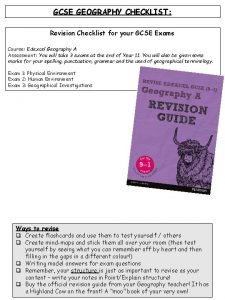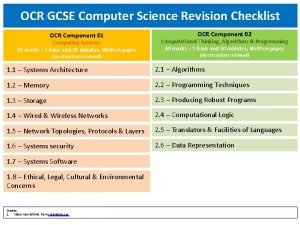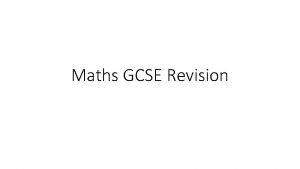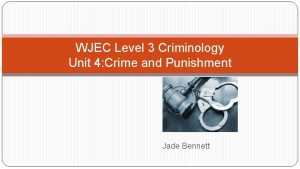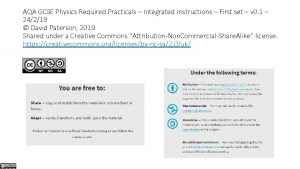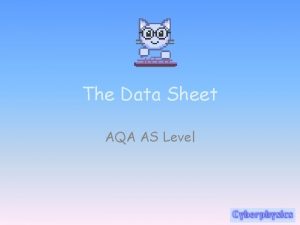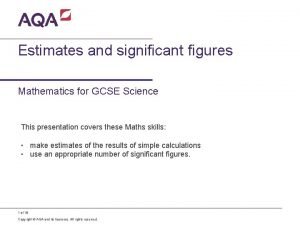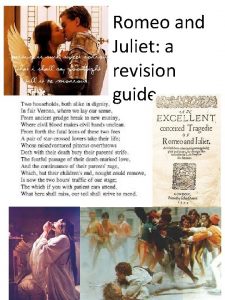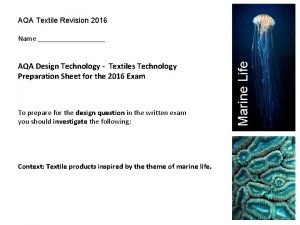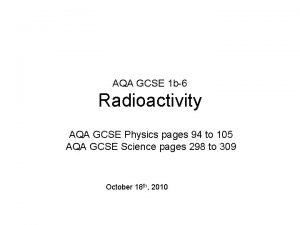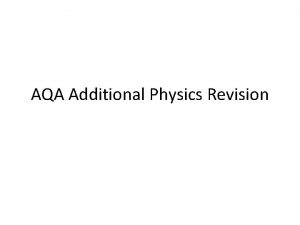AQA Science Physics Unit 1 Revision Notes Energy








- Slides: 8

AQA Science: Physics Unit 1 Revision Notes – Energy CANNOT be created or destroyed Springs Energy types When you add a force (weight) to a spring it extends. * Gravitational Potential – Increased with height * Kinetic Energy – Increased with speed * Elastic Energy – Increased when stretched or squashed * Thermal Energy – Gained when heated, often lost (wasted) to the surroundings Energy Transfers * Mechanically – When a force is applied * Heating – When an object is heated * Electrically – When an object is powered by electricity Extension = Stretched length – original length The energy stored in a spring can be calculate: 2 Kg 3 m A ball rolling down a hill: Gravitational Potential Energy is turned mechanically into kinetic energy Ee = ½ x spring constant x extension 2 (J) (N/m) (m) Power is a measure of how quickly energy is used. The shorter the time the more powerful it is. Power = Energy (J) (W) Time (s) Renewable Sources of electricity ALL turn a turbine to turn a generator. * Wind (Wind turns a turbine) * Hydroelectric (water turns a turbine) * Waves/Tide (The sea turns a turbine) * Geothermal (Heat from volcanoes used to boil water – make steam - turn a turbine) * Biomass (Living material burnt to boil water) Advantages of ALL *Don’t give out CO 2 which causes global warming * Renewable (will NOT run out) Disadvantages They are all more expensive than fossil fuels * Wind – Not always windy * Hydroelectric – Can damage habitats * Waves/Tides – Can damage habitats * Geothermal – Only a few places on Earth * Biomass – Carbon neutral (gives out CO 2 when

AQA Science: Physics Unit 2 Revision Notes – Electricity Static Electricity (Triple only) Examples: Hair standing up after taking a jumper off, rubbing a balloon on your hair. Static electricity is a build up of negative charges (electrons) which are then released. An object is charged if electrons are added or removed. Circuit Symbols Current is the flow of charge (electrons) around a circuit. * It is measured in Amps (A) * It is measured using an Ammeter * In a series circuit the current is the same everywhere. * In a parallel circuit the current splits at each branch. The current through the cell is equal to the current through all the branches added together. The ammeter must be placed in the circuit to take a reading. Resistance is the measure of how hard it is for current to pass through a component. * It is measured in Ohms (Ω) * It is calculated using R=V/I * If you add resisters in series the resistance increases, if you add resistance in parallel the resistance decreases. AC & DC * Alternating Current (AC) the current changes direction. UK mains supply is 230 V and 50 Hz. * Direct Current (DC) flows in the same direction. DC comes from a battery or from a AC supply which has passed through a diode. * The trace works like a graph, with time on the x-axis and voltage on the y-axis. The voltmeter must be placed in parallel with a component in order to measure the PD across it. I-V Curves (Current-Voltage curves) Fixed Resistor Filament Bulb Potential Difference (Voltage) Potential Difference is the amount of energy transferred to a component by each unit of charge. * It is measured in Volts (V) * It is measured using a Voltmeter * In a series circuit the PD of the cell is shared between all the components. The component with the highest resistance receives the most PD. * In a parallel circuit each branch receives the same PD as the cell. Electrical Safety Diode * Fixed Resistor – Straight line shows it is a constant resistance. The steeper the line the lower the resistance. * Filament Bulb – Resistance increases as the bulb heats up and ions vibrate more. * Diode – Only allows current to flow in one direction. The plug and wires are coated in plastic which doesn’t conduct electricity. Safety Devices * Earth Wire – Only needed for devices with a metal casing. Provides a safe route for the current if the live wire touches the casing. Thermistors and LDR’s They have the same shaped graph Electrical fields (Triple only) Field lines travel away from the positive and towards the negative. * LDR’s – Street lighting, cameras * Thermistors – Ovens, fridges, central heating The closer you are to the charge, the stronger the electrical field

AQA Science: Physics Unit 3 Revision Notes – Particle model of matter Density: Internal Energy Changing State Density = Mass (kg) (kg/m 3) Volume (m 3) The energy in a substance is stored in its particles, this is called internal energy. Calculating the density of an irregular shape, can be done using a Eureka can and measuring the volume of water displaced. Internal energy = kinetic energy + potential energy. When a material changes state (melting or boiling) its internal energy increases, but its temperature does not. This means that its kinetic energy remains constant until it has changed state. Specific Latent Heat Pressure and volume Temperature and pressure The specific latent heat of a substance is the energy needed to change 1 kg of the substance with no change in state. Pressure x Volume = constant (Pa) (m 3) Increasing the temperature of a gas increases the kinetic energy of the gas particles, this increases the number of collisions with the surface, this increases the pressure acting on the sides of the container. Energy = Mass x Specific Latent Heat (J) (kg) (J/kg) E=mx. L Specific heat of fusion: when turning from a solid into a liquid Specific heat of vapourisation: when turning from a liquid into gas Temperature: This is linked to the kinetic energy of the gas. T The higher its m temperature the I higher its kinetic n energy. If the temperature e remains constant so consta does the kinetic e energy of the a particles. so P 1 x V 1 = P 2 x V 1 e Changing State Increasing the volume of a gas (making the container bigger) whilst keeping the temperature constant will decrease the pressure of the gas. Particles move in different directions with a range of speeds. As the particles hit the side of the container they create a net force which acts at right angles to the

AQA Science: Physics Unit 4 Revision Notes - Radioactivity Alpha, Beta & Gamma Atoms (Protons + Neutrons) (Protons and electrons) Number of Neutrons = Mass Number – Atomic number (12 - 6 = 6) Isotopes: An isotope is an atom with the same number of protons but different number of neutrons. Ions: An atom that has gained (positive ion) or lost (negative ion) electrons. Name What it is Atomic Structure What is its charge What is its mass Ionising Power Absor bed by Alpha Helium nucleus +2 +4 High Paper/ air Beta Electron -1 Tiny Medium Thin steel Gamma EM Wave 0 0 Low Thick Lead Alpha Decay (Atomic number -2, mass number -4) Beta Decay (Atomic number +1, mass number 0) Some atoms are radioactive, they give out radiation from the nucleus. This is measured in Becquerels (Bq) Half-life The half-life of a radioactive source is the time taken for half the material to decay. The half-life of the material above is 2 days. The starting count was 80 half of it = 40 The time to get to 40 was 2 days. In this example it would take: 2 days to get to 50%, 4 days to 25%, 6 days to get to Nuclear fission (Triple Only) 1. Large radioactive atoms split in half (fission) because they are unstable. 2. When this happens a huge amount of energy is released. 3. Neutrons are released which hit and split more atoms, this is called a chain reaction. 4. This is the source of a nuclear power station or nuclear bomb’s energy 5. Unfortunately a lot of radioactive waste is produced which stays radioactive for 1000’s of years. Nuclear Fusion (Triple Only) 1. Small light nuclei are forced together under huge heat and pressure – such as in the core of the sun. 2. The nuclei repel each other as they are both positively charged so it is hard to get them to fuse. 3. If the temperatures and pressures are large enough the nuclei will fuse to create a larger nuclei 4. A huge amount of energy is released 5. Fusion doesn’t produce any radioactive waste 6. Scientists are yet to develop the technology to allow fusion to be used to produce electricity. 1. In 1901 JJ Thompson suggested the ‘plumb pudding’ model for the atom. With negative particles stuck in the middle of positive charge 2. In 1909 Rutherford changed the accepted model using his alpha scattering experiment. 3 a. He fired alpha particles at a sheet of gold foil. 3 b. He expected them all to pass straight through 3 c. Rarely one would bounce back 3 d. This proved that the center of the atom was very small, held most of the mass and had a positive charge. 3 e. The current model of the atom that we use today was born. Radioactivity (Triple Only) Radioactive atoms decay and release ionizing particles (alpha, beta and gamma) There is a constant level of naturally occurring radiation all around us, this is known as ‘background radiation’. This is random when measured. Background radiation comes from rocks, the air, our food and the sun. Very little comes from man-made devices such as powerstations. Radiation is ionizing, this means it can damage your DNA and in large doses can cause cancer. It can also be used to kill cancerous cells. Professionals working with radioactive sources protect themselves using lead glass. Contamination is when the source is inside you

AQA Science: Physics Unit 5 Revision Notes – Forces and Motion Graphs Motion Distance-Time Speed-Time Stationary Springs (Hooke’s Law) Velocity means speed with a direction. Units: m/s When you add a force (weight) to a spring it extends. Acceleration means the rate of change of velocity. Units: m/s 2 Weight = Mass x Gravity (gravity = 10) (N) Forces Every force has a reaction force which is equal in size, opposite in direction and acts on a different object Constant Speed Accelerating Movement Objects move by applying a force in one direction, the reaction pushes them in the opposite Decelerating Falling Objects 1. When an object is dropped it accelerates as the force of gravity is larger than the force due to air resistance. 2. As it gets faster the air resistance increases. 3. Eventually the force due to air resistance is equal to the force due to gravity. This is known as terminal velocity. 4. At terminal velocity the resultant force is zero. 5. The object remains at a constant speed. Momentum P=mxv The Law of Conservation of Momentum states that the momentum before an event is equal to the momentum afterwards. P = 0 kgm/s Velocity, Acceleration & Weight P = (-20 x 1) + (10 x 2) = 0 Kgm/s Car Safety Stopping Distance = Thinking Distance + Braking Distance Thinking Distance is the distance travelled before the driver has reacted. Affected by: Alcohol, drugs, tiredness, age. Braking Distance is the distance travelled whilst the brakes have been applied. Affected by: Weather conditions (Ice/Snow), condition of the tyres/brakes, road surface. Safety Devices – Seat belts, airbags, crumple zones These devices make the time taken to slow down in the event of a crash longer, which makes the force felt by the driver smaller. Reaction time for an adult is between 0. 2 s and 0. 9 s. It can be tested using a stopwatch. Extension = Stretched length – original length Force = Constant x Extension (N) (N/m) (m) Elastic limit/limit of proportionality. After this point it is permanently deformed Proportional (Straight line) Moments & Levers (Triple Only) Moment = Force x perpendicular distance If an object is balanced then the clockwise moment is equal to the anti-clockwise moment. Levers and gears are used to transmit and magnify the force applied. Pressure in a fluid (Triple Only) A fluid (liquid or gas) causes a force at right angles to any surface that touches it. The deeper an object is in a fluid the greater the pressure, this is because there are more particles above it pressing down on it. The pressure on the underside of a submerged object is greater than the pressure on top, this causes a resultant force = upthrust

AQA Science: Physics Unit 6 Revision Notes - Waves Wave types Transverse: The particles move perpendicular to the direction of travel of the wave. Examples: All EM spectrum eg radio, UV. S-wave Longitudinal: The particles move parallel to the direction of travel of the wave. Examples: Sound, P-waves Labelling a transverse wave Frequency = Number of waves per second (Hz) Labelling a longitudinal wave Frequency = 1__ time Black body radiation (Triple Only) All objects emit and absorb infrared radiation. If it absorbs more than it emits the object’s temperature will increase. A perfect black body will emit and absorb all wavelengths of radiation. The hotter a body the higher frequency of radiation it will emit – hotter object appear white/blue cooler ones red. The Earth If the radiation absorbed by the Earth is greater than the radiation emitted, the Earth’s temperature will increase, this is global warming. Reflection Electromagnetic Spectrum * They travel at the speed of light (3 x 10 8 m/s) * They are all transverse waves * They can all be reflected * They can all be refracted The image created by a mirror is: * Virtual *Equal in size *Equal in distance * Right way up Refraction Gamma rays have the most energy and highest frequency, radio the lowest. Radio has the longest wavelength. Uses Radio – TV and Radio Microwaves – Satellite communication Infrared – Cooking food, remote controls Visible – To see, fibre optics x-rays and gamma – Medical imaging and treatments *Light slows as it enters a denser medium (glass). *It bends towards the normal * Light speeds back up as it leaves the glass and bends away Sound (Triple Only) Lenses (Triple Only) * Sound is a longitudinal wave. * It travels MUCH slower than light * Sound travels faster in solids, slowest in gases. * It needs a medium (particles) to travel through, it will not pass through a vacuum. * Reflected sound is called an echo. * The range of human hearing is 20 -20000 Hz * Large amplitude = Loud * High frequency = High pitched Uses of sound Ultra sound (sound above the range of human hearing) can be used to produce images of the body. Seismic Waves (Triple Only) P-waves pass through solids and liquids, S-waves only pass through solids. This allows us to build up a picture of the Earths inner structure Convex lenses bring parallel rays of light to a focus. The image produced can be real or virtual. Concave lenses always produce a virtual image. The image produced is real (the rays meet), upside down and magnified (The image arrow is bigger than the object) Visible Light (Triple Only) A red object absorbs all wavelengths of light except red which is reflected. If all wavelengths are reflected the object will appear white, if all wavelengths are absorbed the object will appear black. A red filter will absorb all wavelengths of light except red which is transmitted. If a red filter is placed next to a green one no light will pass through, it will look black.

AQA Science: Physics Unit 7 Revision Notes – Magnetism and Electromagnetism Permanent and Induced Magnets Magnetic Fields The Motor Effect Permanent magnets always have a magnetic field around them. North pole and north pole – repel South pole and south pole – repel North pole and south pole - attract Magnetic field lines always point north to south. When an electrical current passes through a wire it produces a magnetic field in the direction shown in the diagram. Induced magnets are materials (iron, steel, nickel and cobalt) which become magnetic when they are placed in a magnetic field. They lose their magnetism when they are removed from the field. Induced magnets always attract! The Earth’s liquid iron core produces a magnetic field. It’s south magnetic pole is actually at the Earth’s geographical North pole. So the north pole of a compass points north Fleming’s Left Hand Rule If a wire carrying a current is placed in a magnetic field they both exert a force on each other. The force on the wire is shown using Fleming’s Left Hand rule. Electric Motor If a loop of wire is placed within a magnetic field it will rotate. The commutator changes the direction of the current around the loop every half turn, this ensures that it will continue to rotate. The current must be DC!! We can plot the field lines by using: a) iron filings b) Plotting compasses. The strongest part of a magnetic field is at the poles, you can see this as the field lines are closest together. The further away you move from the pole the weaker the magnetic field becomes. The Generator Effect (Triple Only) As a coil of wire spins in a magnetic field an electrical current is produced. An alternating current (AC) is produced, unless a commutator is used which only allows the current to travel in one direction. This is a direct current (DC). The current produced can be increased by: * Spinning the coil faster * Having more coils * Stronger magnetic field. The current produces a magnetic field which opposes the original change in direction. The larger the electrical current the stronger the magnetic field produced. Solenoid Coiling the wire to form a solenoid produces a magnetic field similar to a bar magnet. The strength of the magnetic field can be increased by increasing the current or adding an iron core Transformers (Triple Only) Transformers increase (step-up) or decrease (stepdown) the voltage. If there are more coils in the secondary side the voltage will be stepped up. Transformers are used to step-up the voltage, which reduces the current, this makes it more efficient as less energy is wasted as heat. Step-down transformers are then used to make the voltage safe for public use. If we assume that the transformer is 100% efficient then; Powerp = Powers So: Ip x Vp = Is x Is

AQA Science: Physics Unit 8 Revision Notes – Space Physics (Triple only) The Solar System Life-cycle of a star Our star the sun is orbited by planets, dwarf planets, asteroids and comets. Moons orbit the planets. These are all natural satellites. * Gravity pulls dust together in a nebula to form a Protostar. The sun was formed from a nebula pulled together by gravity 5 billion years ago. * When the temperature and pressure is great enough, nuclear fusion begins turning it into a mainsequence star. * When the hydrogen runs out the star collapses as gravity is greater than the pressure from fusion. Heavier elements start to fuse expanding the star to form a red giant. * When the heavier elements run out the star becomes either a white dwarf or explodes in a supernova depending on its size. * The very largest mainsequence stars will eventually become black holes. Slightly smaller stars become neutron stars Making Elements Redshift The Big Bang theory All elements up to iron are made through the fusion of smaller elements in the cores of stars. The larger and hotter the star the heavier the elements it can fuse. Light from a star or galaxy can be used to produce an absorption spectrum. This includes absorption lines, Which indicate the elements present. The Big Bang Theory suggests that the Universe started with a very small hot, dense region and has been expanding ever since. If a star or galaxy is moving towards us then the light from it shows a blueshift. Cosmic Microwave Background Radiation (CMBR) is the left over radiation from the Big Bang and provides further evidence for theory. If the star or galaxy is moving away from us then it shows a red-shift. ALL GALAXIES SHOW RED-SHIFT Evidence All elements heavier than iron are fused during a supernova explosion. This then distributes these elements across the Universe. Objects in Orbit All objects in orbit are accelerating and their velocity is changing, this is because their direction is always changing. If it is a circular orbit then the speed will be constant. If the speed of the object in orbit increases then the radius of the orbit must increase in order to keep it stable. If the speed reduces the radius must also reduce. The further away a galaxy is the faster it is moving away from us. We know this as it shows more redshift. This proves that the universe is EXPANDING, this provides evidence for the BIG BANG theory. This is supported by evidence from the red-shift of galaxies, observations of certain types of supernova and CMBR. Measurements have shown that the expansion of the Universe is increasing in speed. Theories about Dark Mass and Dark Energy help to explain these observations, however more evidence is needed to confirm these ideas.
